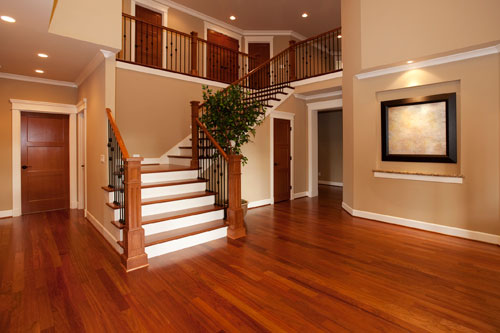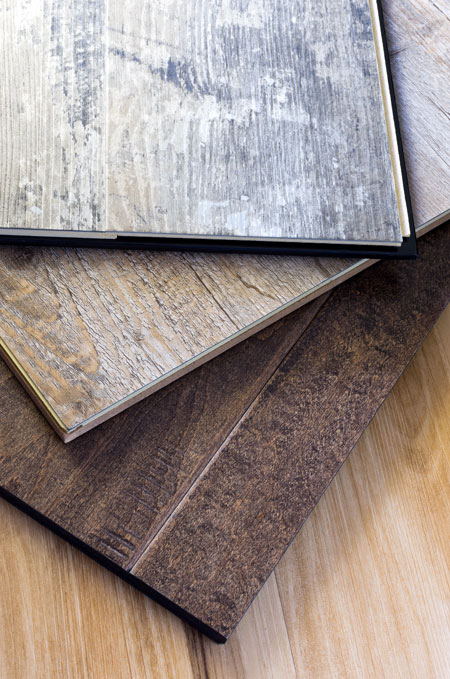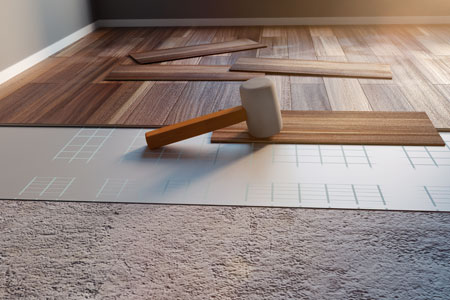Top 10 Flooring Choices for Your Home or Business
Want a new look for your home or business but don’t want to splurge for a full remodel? No problem. You can refresh with a new floor!

A new floor alone will give any space—residential or commercial—a fresh, new look. Rooms you avoided before come alive and start beckoning you to spend time in them.
A new floor can also increase your property value because it will look so amazing and stylish. Prospective buyers will have a hard time resisting it.
The best part? Today, there are more colors, styles, patterns, and types of flooring to choose from than ever before.
10 different flooring types: The pros and cons
1. Solid hardwood
Solid hardwood flooring is made from single pieces of wood using a variety of species.
Pros
Solid hardwood flooring will never go out of style. That’s because it’s both durable and gorgeous. A well-cared-for solid hardwood floor can make even the most modest home feel like a palace. Choose from oak, hickory, maple, cherry, alder, acacia, teak, and more.
Cons
The main drawback of a solid hardwood floor is the price. Hardwood floors can be expensive, both to install and to refinish. They can also be noisy when you walk across them. They can fade when exposed to excessive UV rays, and require a fair amount of maintenance to keep them looking good.
2. Engineered wood

Engineered wood looks like hardwood and consists of a top layer of wood veneer placed over layers of other materials.
Engineered wood flooring consists of a top layer of wood veneer placed over several layers of other materials that have been glued together.
Pros
While it’s not 100% hardwood, engineered wood looks like hardwood after installation and resists moisture better than hardwood. This makes it perfect for use in all rooms. It’s also less expensive than hardwood.
Cons
Some engineered wood flooring holds up better than others. Therefore, you want to make sure you buy from a manufacturer with a reputation for quality. Because the top layer of the floor is wood, engineered wood flooring can fade just like hardwood floors. Therefore, you’ll need to take care that it isn’t exposed to excessive UV rays.
3. Bamboo
Bamboo is a dense, fast-growing grass that can be as durable as some hardwoods.
Pros
If you like the idea of using a natural material but don’t want to spring for hardwood, bamboo flooring is a good choice. It’s less expensive than hardwood though just as durable. It’s easy to install, wears well, and doesn’t need refinishing as often as hardwood.
Cons
The downside of bamboo flooring includes the fact that it scratches and stains easily. Like hardwood, it can fade when exposed to UV rays. Also, low-quality bamboo flooring uses glues that give off volatile organic compounds (VOCs) such as formaldehyde.
4. Tile
Tile flooring is made from ceramic, natural stone, and other hard materials.
Pros
A tile floor is extremely durable, moisture-resistant, and hard to stain. Designers love it because it comes in a wide variety of shapes and colors. Tile flooring is great for bathroom and kitchen flooring.
Cons
A tile floor is hard and requires maintenance to keep the grout lines looking clean. It also feels cold when you walk on it.
5. Laminate

Laminate flooring is inexpensive compared to other types of flooring and can be made to look like hardwood or even stone.
Laminate flooring consists of particle board covered by an image layer and then topped off with a see-through wear layer.
Pros
Laminate flooring is inexpensive compared to other types of flooring, which is one reason it’s so popular. It’s also resistant to scratches, stains, and dents. Laminate flooring can be made to look like hardwood or even stone.
Cons
While laminate flooring is designed to look like wood, it’s not wood, and that means it can’t be refinished. While the see-through wear layer is designed to withstand wear and tear, it can still get damaged. If that happens, the best solution is to replace the plank. However, that might be difficult. You’ll also get mixed results if you try to repair the damage to the plank.
6. Sheet vinyl
Sheet vinyl flooring is usually made from polyvinyl chloride, a common synthetic plastic polymer.
Pros
Sheet vinyl flooring is even less expensive than vinyl plank flooring because the big rolls are mass-produced. It’s easy to install and maintain and is good for bathrooms because it’s moisture-resistant and easy to clean. It also comes in a wide variety of styles.
Cons
Sheet vinyl must be installed over a perfectly smooth subfloor. This is because vinyl is soft, and if there is any debris on the subfloor, it can cause bumps and even tears. If that happens, you’ll probably need to replace the entire floor because spot fixes with sheet vinyl are next to impossible. While you could replace the damaged area with a patch, the floor will no longer be water-resistant.
7. Vinyl plank
Vinyl plank flooring is vinyl flooring in the form of long, narrow strips that look like planks.
Pros
Vinyl plank flooring is moisture-resistant and good for bathrooms, kitchens, or homes with pets. It’s also durable and stands up well under heavy use. It’s easy to install and maintain and is a cost-effective flooring solution for anyone on a budget.
Cons
Unfortunately, vinyl plank flooring punctures easily. So don’t drop something sharp on it. It’s also susceptible to indentations caused by furniture and can fade or discolor when exposed to UV rays.
8. Linoleum
Linoleum flooring has been around for a long time. It’s made from linseed oil and other natural materials and is sold in sheets or tiles.
Pros
Linoleum flooring is durable and easy to install. It’s also easy to maintain and comes in a wide variety of styles, colors, and patterns. People like it because it’s a soft material and therefore comfortable to stand and walk on.
Cons
Linoleum flooring is easily scratched or torn. Also, some owners are bothered by the fumes it gives off when it is first installed. Linoleum flooring also needs to be properly maintained or it will look old and dingy.
9. Cork
Cork flooring is made from the bark of the Quercus suber tree, commonly referred to as the cork oak tree. The bark of the tree is ground up, made into sheets, and then baked to produce the cork tiles used for flooring.
Pros
Cork flooring is an inexpensive option made from a renewable resource. It absorbs sound, comes in a variety of colors and patterns, and is perfect for anyone with cold feet because it stays at room temperature. It is also a quickly renewable resource, even faster than more traditional wood.
Cons
It is easily damaged by furniture and pets. Think dents and scratches. It will also fade and discolor if exposed to UV rays.
10. Carpet
Carpeting is a textile-based floor covering created by attaching a layer of pile to a backing.
Pros
Carpeting is a relatively inexpensive option that will make any room feel warm and cozy. It’s soft to walk on, easy to install, and great at absorbing sound. Just make sure you install a quality carpet pad underneath to get the most of these benefits!
Cons
Carpeting is probably the least durable flooring material on the market today. Wear and tear in areas with high traffic is easy to see, and for obvious reasons, it can’t be used in kitchens or bathrooms. That doesn’t stop some people from trying though.
Don’t let moisture issues cause your carpet to smell.
New flooring types: Hemp
One type of flooring you probably haven’t heard about is made from hemp. It is very new and from what we can tell, Hempwood, a Kentucky-based company, is the only manufacturer right now. According to Hempwood, hemp flooring is eco-friendly, durable, and easily customizable.
What are the most durable types of flooring?
Tile and hardwood are, without a doubt, the two most durable flooring types on the market. Tile is highly resistant to scratches, dents, and moisture. With hardwood, you can refinish it over and over again and it will look as good as new each time.
What are the best types of flooring for a living room?
Top flooring choices for a living room include carpet because of the ‘’warm and cozy’’ factor, hardwood or engineered wood flooring because of its durability, and vinyl plank because it’s easy to maintain and holds up well under heavy use.
Enjoy a new floor today
If splurging for a full remodel isn’t in your budget, that doesn’t mean you can’t spruce up your home with a gorgeous new floor. It’s easy to do, economical, and the difference will amaze you. Fortunately, today you have a wide variety of flooring options to choose from. With each one, there are a variety of types, styles, patterns, and colors. So go ahead—get creative, and enjoy your updated look!
Jason has 20+ years’ experience in sales and sales management in a spectrum of industries and has successfully launched a variety of products to the market, including the original Rapid RH® concrete moisture tests. He currently works with Wagner Meters as our Rapid RH® product sales manager.
Related Posts via Taxonomies
Last updated on November 10th, 2021



